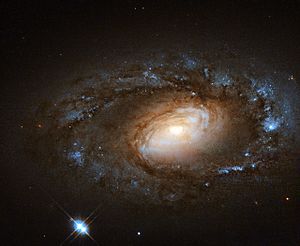NGC 4102 facts for kids

NGC 4102 is a fascinating spiral galaxy located in the constellation of Ursa Major, which you might know as the Big Dipper! This galaxy is incredibly far away, about 69 million light-years from our home planet, Earth. Imagine how long it takes light from NGC 4102 to reach us!
Contents
What is a Galaxy?
A galaxy is like a giant island in space, filled with billions of stars, planets, gas, and dust. All these things are held together by a powerful force called gravity. Our own solar system, with Earth and the Sun, is part of a galaxy called the Milky Way.
Types of Galaxies
Scientists group galaxies into different types based on their shape. The main types are:
- Spiral galaxies: These look like giant pinwheels with swirling arms.
- Elliptical galaxies: These are more oval or egg-shaped.
- Irregular galaxies: These don't have a clear shape and often look a bit messy.
Exploring NGC 4102
NGC 4102 is a type of spiral galaxy. This means it has a bright center and long, winding arms that spiral outwards. These arms are where many new stars are born, shining brightly.
Where is NGC 4102 Located?
You can find NGC 4102 in the northern sky, within the constellation of Ursa Major. While you can't see it with your eyes alone, powerful telescopes like the Hubble Space Telescope can capture amazing images of it.
The distance to NGC 4102, 69 million light-years, is a huge number! A light-year is the distance light travels in one year. Since light is the fastest thing we know, this gives you an idea of just how vast the universe is. When we look at NGC 4102, we are actually seeing it as it was 69 million years ago, because that's how long its light took to reach us!
Galaxy Clusters
NGC 4102 is also part of a group of galaxies called the Ursa Major Cluster. Just like stars can be found in groups, galaxies often hang out together in clusters. These clusters can contain hundreds or even thousands of galaxies, all bound together by gravity. Studying these clusters helps scientists understand how galaxies form and evolve over billions of years.

